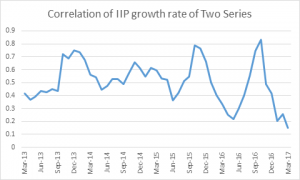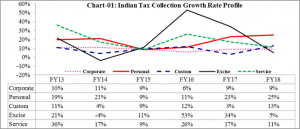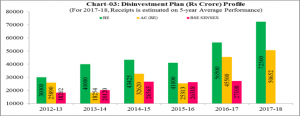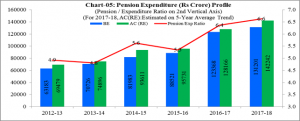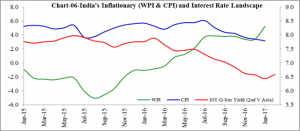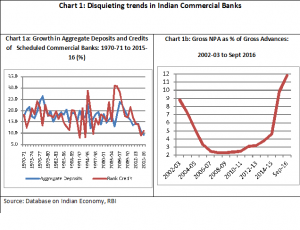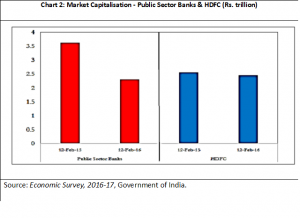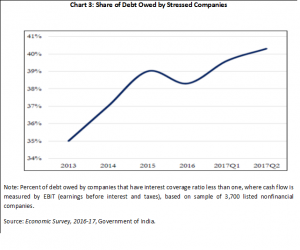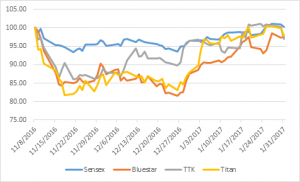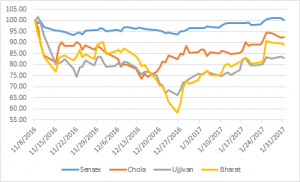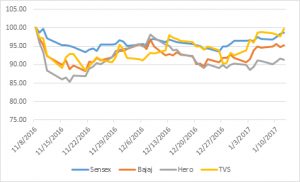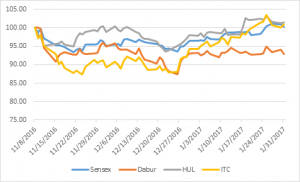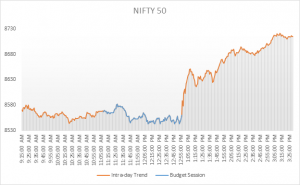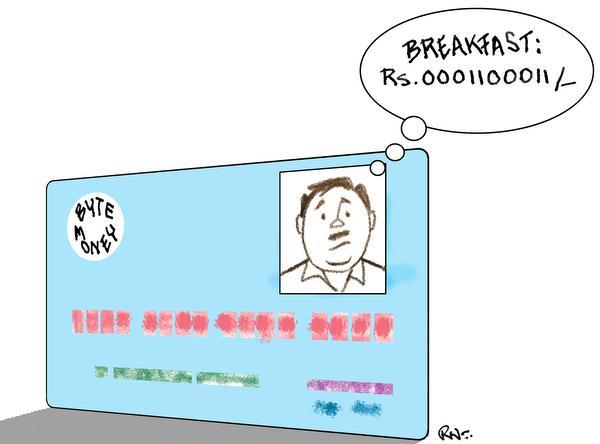It is believed that capital markets do not like (earning) surprise and hence companies systematically resort to earnings management practices to smoothen the effect of ‘surprise’. The regulatory requirements for publication of quarterly financial results have made management of firms myopic resulting in supposedly greater earnings management. While the intention of the regulator in seeking frequent financial information from listed firms was to protect investors, markets have become increasingly unforgiving of companies that miss their estimates. For example, annual earnings (profits) of Dr. Reddy’s Laboratories Ltd. (DRL) for 2016-17 was reported on 12 May 2017 at Rs. 72.61 compared to an estimate of Rs. 82.88 for the same period-, resulting in an earnings surprise of -12.4%. Market reaction was severe- the share price tumbled from Rs. 3097 in early February 2017 to Rs. 2414 on 26 May 2017- a fall of 22%. This kind of market reaction may create undue pressure on the management to ‘perform’. A popular way to avoid such severe market reaction is to manage earnings in such a way that the earnings surprise is limited and at the same time disclosures are within regulatory limits. But why should an unlisted company manage earnings? There is no ‘market’ expectations that need to be managed for unlisted firms. The possible reasons could be institutional ownership and leverage. A study[1] finds that firms with higher institutional holdings report better earnings quality. Foreign institutional ownership also has a negative relationship with the degree of earnings management by firms, the study reports. Another study[2] looks at the relationship between the level of corporate governance and earnings management of firms. Using a sample of 2315 non-financial listed companies, the study finds a negative association between corporate governance attributes and earnings management. The study also observes that the relationship between institutional investors and earnings management indicated existence of a ‘short horizon’ problem. Firms with higher leverage have tendency to manage earnings to ‘delay’ any bad news to the lenders. Our study finds that managing earnings is not a monopoly of listed companies.
Experts believe that accrual basis of accounting is the source of earnings management. Historically, accountants have argued that accrual based of financial reporting enables the firm to recognize the timing of cash flows in sync with its performance, inclusion of accruals in earnings presents a more accurate portrayal of firms’ economic performance. However, accrual basis of accounting allows managers of a firm grater ‘discretion’ in reporting financial elements in the financial statements. While managers resort to income increasing or decreasing earnings management to minimize ‘shock’ or reduce cost of capital, any news of earnings management result in adverse consequences for investors. Regulators are, therefore, worried about this practice. For example, the Securities and Exchange Commission (SEC) of USA periodically reviews companies’ filings and monitors compliance with regulatory disclosure and accounting requirements. Similar practices are also followed by SEBI in India. However, whether such regulatory oversight improves earnings quality (i.e., reduces earnings management) of firms is an open question. Empirical evidence in this regard are mixed.
In 2013, SEBI released a study by its Development Research Group on earnings management[3] which examines and quantifies the extent of earnings management in India. The study looked at a cohort of 2229 listed Indian (non-financial) companies during 2008-11. The study finds that average earnings management in Indian corporate sector was 2.9% of total assets. The study also finds that small firms indulge in greater earnings management (around 10% of total assets).
Measuring Earnings Management
Earnings management ranges from ‘manipulation to opportunism’. Earnings management refers to adjustment of financial reporting numbers for managerial self-interests. Technically speaking earnings management is not illegal as the accounting principle provides the firm management to use their discretion and judgment in financial reporting. The research on accrual management focuses on separating managed accruals from normal accruals. It is not easy to identify the managed accruals. Elgers, Pfeiffer and Porter[4] mention that a ‘fundamental issue in assessing earnings management is the un-observability of the managed and un-managed components of reported earnings’. The part of the accrual normal to an industry is called non-discretionary component of accrual. Discretionary accrual refers to the difference of actual accrual and non-discretionary accrual. The use of discretionary accrual as a measure of earnings quality is widespread in the literature. We briefly describe the methodology of earnings management.
Formally accrual can be defined as difference between accrual earnings and cash earnings. In the absence of accrual earnings both types of earnings would result in same figure. Cash earnings can be stated as
On the other hand, the accrual based earnings can be stated as,
One can express accrual as
This is the expression used in the present study to calculate balance sheet accrual (BS accrual).
Moreover, Hribar and Collins[5] point out that BS accrual is vulnerable to non-articulation events. They define non-articulation events as non-operating events such as divestiture, mergers and acquisitions and foreign currency translations. They show that mergers and acquisitions have positive bias whereas divestiture and discontinued operation have negative bias in BS accrual. Thus they recommend measuring total accrual directly from cash flow statement. Following their methodology we calculate CF accrual as:
To estimate discretionary accrual first we have to estimate non-discretionary accrual component and then subtract the non-discretionary part from total accrual to obtain discretionary accrual. The non-discretionary accrual is computed using modified version of cross-sectional Jones model[6], where plant, purchase and equipment, change in revenue less receivable, return and cfo(operating cash flow) has been considered as control variable.(all variables are scaled by lagged total asset).
First the non-discretionary component of accrual is estimated by the following expression-
Then the discretionary accrual ratio is computed by subtracting non-discretionary component from total accrual.
This discretionary accrual measures that part of accrual which is manipulated by the management for inflating or deflating profit. Therefore, larger proportion of discretionary accruals denotes higher earnings management.
Earnings Management Score (EMS)
We have developed a proprietary earnings management score (EMS) where a higher number indicates greater earnings management. Thus EMS quantifies the magnitude of each firm’s earnings management. The score is calculated using six variables for each firm- balance sheet and cash flow total accruals, balance sheet and cash flow discretionary accruals, the correlation between net income (profit after tax) and balance sheet and cash flow total accruals. For each year the total range of each variable is divided into six quintiles obtained from 16.66, 33.33 50, 66.67 83.33 and 100 percentile values of the variable. A firm-year observation is given a weight between 0.25 and 4 based on the following scheme:
Table 1: Weighting Scheme
| Quintile Range | Weight |
| First (<16.66) | 0.25 |
| Second (16.66- 33.33) | 0.50 |
| Third (33.33-50) | 1 |
| Fourth (50-66.67) | 2 |
| Fifth (66.67-83.33) | 3 |
| Sixth (>83.33) | 4 |
The above range of values is obtained for each firm twice based on its position – one at the overall level (based on 1691 companies) and again at industry level (based on number of companies in an industry). For example, a firm may have a value of discretionary balance sheet accrual at the third quintile based on the entire sample of 1691 firms and at the fifth quintile based on values of firms from the same industry. Thus for each of the 6 variables we have created two weights (one for its position at the overall level and the other for its position at the industry level). So we have 12 weights for each firm-year observation. Finally, earnings management score is calculated following a proprietary method using the weighted variables of the six variables.
Shareholding Pattern and EMS
Our study uses data of 1691 non-financial companies, covering 37 industries, for which complete information are available from 2005-06 through 2015-16. Necessary financial data for each firm is obtained from Ace Equity database. Our results show that any EMS above 2000 indicates strong earnings management. Table 2 shows that more than 50% of firms in our sample have an EMS of greater than 2000. More than 10% of firms have EMS greater than 5000. Thus, earnings management is rampant in India.
Table 2: Frequency Distribution of EMS
| Range | No of companies | Cumulative Frequency |
| 0-100 | 120 | 7.09% |
| 100-1000 | 221 | 20.16% |
| 1000-2000 | 364 | 41.69% |
| 2000-3000 | 348 | 62.27% |
| 3000-4000 | 248 | 76.93% |
| 4000-5000 | 188 | 88.05% |
| >5000 | 202 | 100% |
| Total | 1691 |
The relationship between promoters’ holding and EMS (table 3) is not straightforward. Initially EMS increased linearly with increase in promoters’ holding (entrenchment hypothesis) and thereafter (promoters’ holding beyond 75%) EMS decreases with increase in holding (alignment hypothesis). Entrenchment hypothesis states that controlling shareholders (read promoters) entrench by managing earnings upwards as their control rights becomes greater than their cash flow rights. As cash flow rights (i.e., ownership) of promoters increase, the level of discretionary accruals of the controlled firms tends to decrease. Alignment hypothesis suggests that the incentive for earnings management decreases as inside owners interests are aligned with interest of ‘outside’ shareholders. It is observed that beyond 30% of promoters holding, EMS is almost static till 70% and then declines. There was a sharp fall in the score beyond 75% implying thereby that promoters do not resort to much earning management when a company becomes private.
Table 3: Relationship between Promoters’ Shareholdings and EMS
| Promoter Shareholdings | No of Companies | EMS |
| <1% | 26 | 340 |
| 1-10% | 17 | 2230 |
| 10-20% | 32 | 2225 |
| 20-30% | 118 | 2355 |
| 30-40% | 227 | 2340 |
| 40-50% | 296 | 2360 |
| 50-60% | 364 | 2350 |
| 60-70% | 286 | 2355 |
| 70-80% | 178 | 2400 |
| 80-90% | 46 | 1840 |
| 90-100% | 79 | 1920 |
Results for Institutional holdings are more pronounced (Table 4). The average EMS is high when there is less monitoring by institutional owners. But once institutional holding crosses 25% (signifying some level of monitoring with voting rights), EMS decreases. Our EMS is designed in such a way that any score less than 2000 signifies lower level of earnings management which should not invite legal scrutiny.
Table 4: Relationship between Institutional Shareholdings and EMS
| Institutional Shareholdings | No of Companies | EMS |
| <1% | 557 | 2340 |
| 1-5% | 312 | 2585 |
| 5-10% | 245 | 2330 |
| 10-15% | 189 | 2360 |
| 15-20% | 126 | 2335 |
| 20-25% | 83 | 2230 |
| 25-30% | 51 | 1370 |
| 30-35% | 42 | 2240 |
| 35-50% | 45 | 1240 |
| >50% | 19 | 1560 |
Financially Stressed Firms and EMS
Some studies[7] show that lenders’ monitoring would lead to lower earnings management. Hence, firms with higher institutional (bank) debt should observe lower earnings management (discretionary accruals). The opposite view suggests that in order to avoid debt covenant violation, firms with high debt are more likely to apply discretion in its reported earnings. Our study supports the latter view.
We have compared credit ratings of Indian firms and the EMS score (Table 5). Median EMS of AAA rated firms in our sample is 1450 while median EMS of D rated firms is 2340. Table 5 shows a sample set of ten AAA-rated and similar number of D-rates firms and their corresponding EMS. It clearly shows that firms with financial distress (lower ratings) resort to greater earnings management to delay the bad news and perhaps to satisfy certain debt covenants.
Table 5: Credit Ratings and EMS
Panel A: EMS of AAA rated firms
| Company Name | Rating | Rating Date | Ugrade/downgrade | EMS Score |
| Cairn India Ltd. | AAA | 5/13/2015 | Withdrawn | 0 |
| GSPL India Gasnet Ltd. | AAA | 10/18/2016 | Reaffirmed | 0 |
| GSPL India Transco Ltd. | AAA | 10/18/2016 | Reaffirmed | 0 |
| Unique Estates Devp. Company Ltd. | AAA | 2/27/2017 | Reaffirmed | 0 |
| Aditya Birla Telecom Ltd. | AAA | 2/19/2010 | Revised | 10 |
| Gulf Oil Lubricants India Ltd. | AAA | 2/13/2017 | Reaffirmed | 10 |
| Indian Petrochemicals Corporation Ltd. [Merged] | AAA | 3/16/2007 | Reaffirmed | 10 |
| Mazagon Dock Ltd. | AAA | 10/12/2015 | Withdrawn | 10 |
| ONGC Mangalore Petrochemicals Ltd. | AAA | 3/10/2017 | Affirmed | 10 |
| Bombay Burmah Trading Corporation Ltd. | AAA | 4/5/2017 | Reaffirmed | 20 |
| GAIL (India) Ltd. | AAA | 4/10/2017 | Affirmed | 20 |
Panel B: EMS of D rated firms
| Company Name | Rating | Rating Date | Ugrade/downgrade | EMS Score |
| LML Ltd. | D | 12/26/2016 | Reaffirmed | 10100 |
| Paramount Communications Ltd. | D | 9/17/2015 | Suspended | 8990 |
| Hiran Orgochem Ltd. | D | 5/19/2011 | Suspended | 8880 |
| Facor Alloys Ltd. | D | 2/14/2017 | Reaffirmed | 8210 |
| Shreyas Intermediates Ltd. | D | 12/16/2013 | Suspended | 8110 |
| Vimal Oil & Foods Ltd. | D | 12/30/2016 | Reaffirmed | 8000 |
| ICSA (India) Ltd. | D | 11/23/2011 | Downgraded | 7990 |
| Omnitech Infosolutions Ltd. | D | 6/8/2015 | Suspended | 7990 |
| Quintegra Solutions Ltd. | D | 12/4/2013 | Withdrawn | 7990 |
| Tecpro Systems Ltd. | D | 10/27/2016 | Reaffirmed | 7780 |
| Refex Industries Ltd. | D | 5/15/2014 | Suspended | 6990 |
We have also looked at the EMS of firms experiencing various stages of financial stress using a proprietary dataset that classifies firms into three buckets- highly stressed, vulnerable, and non-vulnerable. Our results (Table 6) again supports the hypothesis that financially stressed firms resort to greater earnings management.
Table 6: EMS and Level of Financial Distress
| Classification | Median EMS |
| Highly Stressed | 3570 |
| Vulnerable | 2370 |
| Not Vulnerable | 1460 |
Conclusions
Opportunistic earnings management by firms is a matter of concern of regulatory authorities. Therefore, a comprehensive measure of earnings management would help regulators in identifying firms that resort to greater degree of earnings management. The difficulty in developing such a measure is that the variable (earnings management) itself is unobservable. It is easy to define the concept of earnings management. But it is extremely difficult to identify a suitable proxy for it. Experts have so far used total accrual or more popularly, discretionary accrual as a proxy for earnings management. Our study uses a list of six variables to estimate a comprehensive earnings management score. Our study provides insights into the relationship between earnings management and shareholding pattern. Further our study shows that financially stressed firms resort to greater level of earnings management. We believe that regulators, financial institutions and even investment managers would find our EMS effective and useful.
*********
[1] Institutional Ownership and Earnings Management in India, Ravitha Ajay, R. Madhumathi. Indian Journal of Corporate Governance, Vol 8 Isue 2 pp 119-136
[2] Exploring the Relation between Earnings Management and Corporate Governance Characteristics in the Indian Context, Jaiswall Manju, Ashok Banerjee. Corporate Governance in India. A report by the Indian Institute of Corporate Affairs , Thought Arbitrage Research Institute and Indian Institute of Management Calcutta
[3] Earnings Management in India, SEBI DRG Study 2013 (http://www.sebi.gov.in/sebi_data/DRG_Study/EMiM.pdf accessed on 30 May 2017)
[4] Anticipatory income smoothing: a re-examination. Elgers, P.T., Pfeiffer, R.J. and Porter, S.L. 2003, Journal of Accounting and Economics, 35(3), pp.405-422
[5] Errors in estimating accruals: Implications for empirical research, Hribar, P. and Collins, D.W., 2002 Journal of Accounting research, 40(1), pp.105-134
[6] Detecting earnings management, Dechow, P.M., Sloan, R.G. and Sweeney, A.P., 1995. Accounting review, pp.193-225.
[7] Earnings Management and Financial Distress: Evidence from India, Khusbu Agrawal and Chanchal Chatterjee. 2015, Global Business Review, Vol 16, Issue 5_suppl pp 140S-154S






